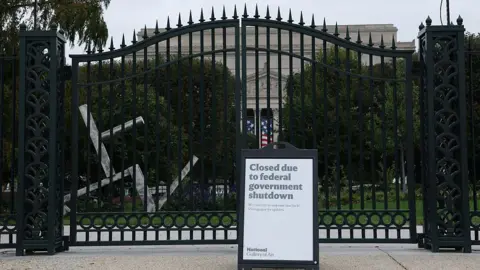As US shutdown starts to bite, how much could it hit economy?

Natalie ShermanBusiness reporter
 Getty Images
Getty ImagesMichael Galletly, who works for the Department of Agriculture in Utah, sat down with his wife last week, combing through bills and spending for more than two hours to strategise how to make it through the government shutdown.
The outlook – uncertain.
“I could make it two months, maybe three lean, very lean months,” said Mr Galletly, an IT management specialist, who is also president of American Federation of Government Employees Local 4016. “But I don’t know how long this thing is going to go.”
The impasse has already snarled travel, delayed government approvals for permits and loans and shuttered some museums.
Now as millions of federal workers across the government start to miss paycheques this week and respond by curtailing spending, analysts say the impact will start to reverberate more widely.
“We’re reaching this critical inflection point in terms of the government shutdown and its ramifications for the broader economy,” said Stash Graham, managing director of Graham Capital Management.
There are already signs that business and consumer confidence have dropped, in a possible indicator of economic weakness ahead.
Analysts said the delay or suspension of key releases of economic data, like the monthly jobs report, is adding to uncertainty, prompting firms to put spending decisions on hold and raising the risk of error as policymakers proceed without the best information.
In Utah, Mr Galletly said he had started to pull back his purchases in the lead-up to the shutdown, scrapping plans to buy a camper trailer, opting for a second-hand laptop for his daughter, and postponing plans to replace windows, including one that is leaking.
Now, with the prospect of missing his first paycheque next week, he has applied for unemployment insurance, and reached out to the banks holding his mortgage and car loan, hoping for accommodation.
“A lot of people tend to look at these things and just hope for the best,” he said. “Having been through this before – this is my third government shutdown as a federal employee – I just can’t afford to do that.”
 Michael Galletly
Michael GalletlyThe impact of government shutdowns on the economy is typically temporary and limited – kind of like the disruption from a hurricane or major storm.
Analysts this year project a hit to quarterly growth of roughly 0.2 percentage points per week – roughly $15bn (£11.2bn) – much of which would be made up after the shutdown ends, when federal workers typically receive back pay.
This year’s clash, however, carries unusual risks.
The Trump administration is threatening unprecedented action – including denying backpay to workers and permanent firings, which it started to initiate last week.
And the fight is colliding with a slowing economy, in which businesses and households were already worried over tariffs, changes to immigration rules and earlier cuts to government spending.
“We’ve already rolled the dice a lot this year,” said Michael Zdinak, economics director at S&P Global Market Intelligence.
“So while the impact of a short shutdown should be minimal, a protracted government shutdown is just another chance we’re taking that could derail the trend of steady growth we’ve been on the last couple of years.”
In recent days, the Trump administration has moved to blunt some of the economic pain, reshuffling government payments to ensure military members continue to receive pay and certain key food programmes maintain funding.
But those measures have also dimmed hopes of a resolution, removing some of the pressure points that had been expected to get the two sides talking about how to resolve their differences over spending.
“If the shutdown drags deep into next week, we will be venturing into uncharted territory,” Wells Fargo analysts wrote recently, noting that most prior shutdowns, especially lengthy ones, have been far more limited in scope.
S&P Global Market Intelligence estimates that the unemployment rate could rise to as much as 4.8% if the shutdown continues until 18 October – a significant leap up from 4.3%.
The White House Council of Economic Advisers recently estimated that a month-long shutdown could lead to the loss of $30bn in consumer spending, in part due to the impact on government contractors, which number in the millions and are not eligible for back pay if their work is affected.
Allison, whose husband is employed by the Defense Department in Ohio and is now working without pay, said her family of five had already cancelled its typical fall weekend getaway to Michigan, opting for a day trip instead to save money.
Though Allison works for the state, her husband is the primary breadwinner.
The 43-year-old, who asked the BBC not to publish her full name due to concern it would expose her to political attacks, said her family has little wiggle room in its budget after the jump in living costs in recent years.
When the shutdown started, they immediately reached out to the bank to ask if they could defer November’s mortgage payment. She is worried an extended shutdown will force her children to drop out of extracurricular activities.
“If this continues through December, I don’t know what we’re going to do,” she said.



